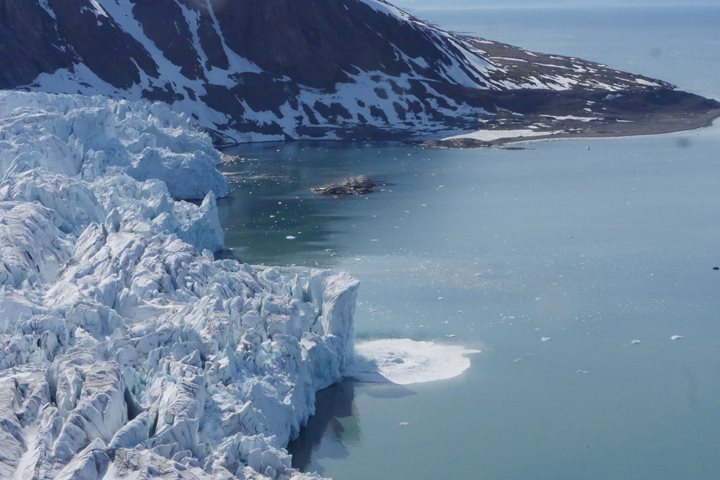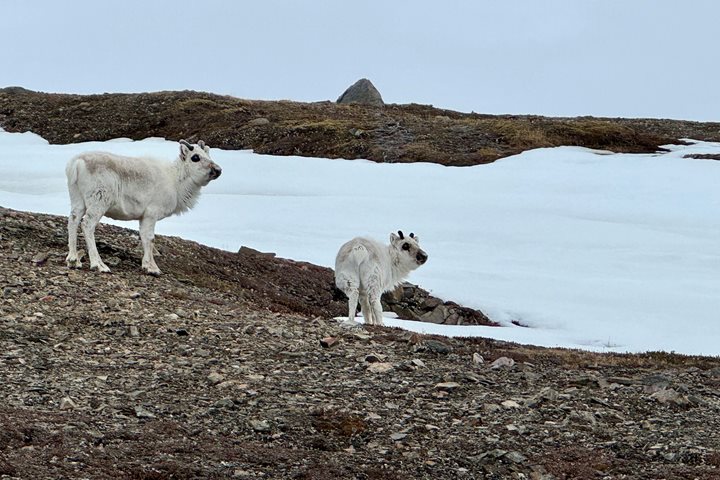Having sailed north through the night along the western coast of Spitsbergen, the largest island in the Svalbard Archipelago, we had reached the southern edge of the sea ice by 0400. Our intentions were to poke into Raudforden, a small fjord system on the northwestern tip of Spitsbergen, in hopes of spotting some wildlife utilizing the remaining fast ice held inside the fjord. Fast ice is sea ice that forms along the shores and is held “fast” to the surrounding land. By the time we reached Hamiltonbukta, a small indentation in the shoreline of the larger fjord, we were just a mile or so off the edge of the fast ice. Scanning the expansive, flat, white surface of the fast ice, we began spotting tiny, sausage-shaped spots scattered about on the ice. Ringed and bearded seals were hauled out on the ice near their breathing holes. Our main quest for the day was the isbjørn, or the ice bear. Sure enough, shortly before breakfast, we spotted our first polar bear of the trip, a lone male bear making its way across the icy expanse. After a brief announcement to inform guests of our find, the bridge and outer decks filled with excited guests with binoculars and cameras in hand. Everyone was ready to observe this magnificent sight. The bear was rather distant, out in the middle of the sprawling sea ice, but he was still quite visible. It is amazing to watch one of these creatures in its natural surroundings. While taking in the scene ahead of us, it wasn’t long until off our starboard side, nearer to shore and in the wide open, another bear was spotted. This time it was a female bear with a second-year cub in tow. We repositioned the vessel to make an approach to observe these two bears. We were able to get much closer to her and her cub as they negotiated the still snow- and ice-covered shoreline, methodically making their way along the shore. We had the good fortune of observing this pair for over an hour. The cub occasionally lagged too far behind its mother, who stopped and looked over her shoulder to encourage her increasingly independent offspring to catch up. In our last moments of observation, these two animals came across what appeared to be the remains of a reindeer carcass still bearing some flesh and sinew for the pair to consume.
We slowly departed Raudfjorden and made a careful navigation through the stringers of sea ice. We headed farther northeast, making our way to Briebogen, another shallow bight in the coastline that still had extensive fast ice. In the intermediate time, naturalist Doug Gualtieri gave a presentation on the natural history of polar bears and life on the ice for the bears of Svalbard. Shortly after lunch, we were back at it. We spotted our fourth bear of the day as it traversed the fast ice in search of seals. We observed this individual for a good long while, eventually leaving the scene to unfold without us. Midafternoon, National Geographic photographer Greg Winston gave a presentation on photography. He highlighted aspects of bear photography to enhance our guests’ knowledge. Expedition leader Stefano Pozzi and Captain Aaron Wood hatched a scheme for us to seek out a large floe of multiyear sea ice to give guests a once in a lifetime experience. Sure enough, we found the perfect patch of ice at about 150 meters by 150 meters and over two meters thick very near the ship. Soon the ice floe was teeming with blue parkas and exuberant exclamations from every corner. A more fitting conclusion to an already excellent day would be hard to imagine.







